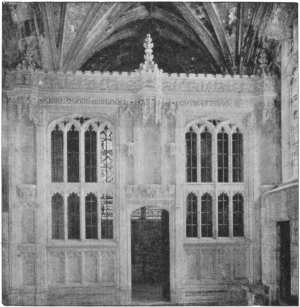 |
| Title: Vanishing England Author: P. H. Ditchfield (1910) Project Gutenburg |
"Many of them [Churches] have been used as quarries, and only a few stones remain to mark the spot where once stood a holy house of God. Before the Reformation the land must have teemed with churches. I know not the exact number of monastic houses once existing in England. There must have been at least a thousand, and each had its church. Each parish had a church. Besides these were the cathedrals, chantry chapels, chapels attached to the mansions, castles, and manor-houses of the lords and squires, to almshouses and hospitals, pilgrim churches by the roadside, where bands of pilgrims would halt and pay their devotions ere they passed along to the shrine of St. Thomas at Canterbury or to Our Lady at Walsingham. When chantries and guilds as well as monasteries were suppressed, their chapels were no longer used for divine service; some of the monastic churches became cathedrals or parish churches, but most of them were pillaged, desecrated, and destroyed. When pilgrimages were declared to be "fond things vainly invented," and the pilgrim bands ceased to travel along the pilgrim way, the wayside chapel fell into decay, or was turned into a barn or stable.
It is all very sad and deplorable. But the roll of abandoned shrines is not complete. At the present day many old churches are vanishing. Some have been abandoned or pulled down because they were deemed too near to the squire's house, and a new church erected at a more respectful distance. "Restoration" has doomed many to destruction. Not long ago the new scheme for supplying Liverpool with water necessitated the converting of a Welsh valley into a huge reservoir and the consequent destruction of churches and villages. A new scheme for supplying London with water has been mooted, and would entail the damming up of a river at the end of a valley and the overwhelming of several prosperous old villages and churches which have stood there for centuries. The destruction of churches in London on account of the value of their site and the migration of the population, westward and eastward, has been frequently deplored. With the exception of All Hallows, Barking; St. Andrew's Undershaft; St. Catherine Cree; St. Dunstan's, Stepney; St. Giles', Cripplegate; All Hallows, Staining; St. James's, Aldgate; St. Sepulchre's; St. Mary Woolnoth; all the old City churches were destroyed by the Great Fire, and some of the above were damaged and repaired. "Destroyed by the Great Fire, rebuilt by Wren," is the story of most of the City churches of London. To him fell the task of rebuilding the fallen edifices. Well did he accomplish his task. He had no one to guide him; no school of artists or craftsmen to help him in the detail of his buildings; no great principles of architecture to direct him. But he triumphed over all obstacles and devised a style of his own that was well suitable for the requirements of the time and climate and for the form of worship of the English National Church. And how have we treated the buildings which his genius devised for us? Eighteen of his beautiful buildings have already been destroyed, and fourteen of these since the passing of the Union of City Benefices Act in 1860 have succumbed. With the utmost difficulty vehement attacks on others have been warded off, and no one can tell how long they will remain. Here is a very sad and deplorable instance of the vanishing of English architectural treasures. While we deplore the destructive tendencies of our ancestors we have need to be ashamed of our own".
